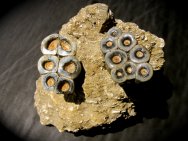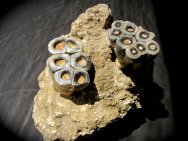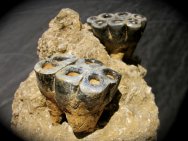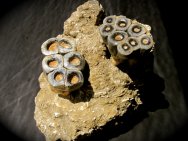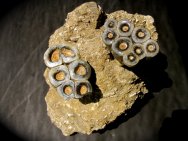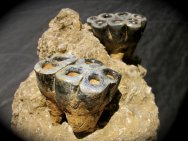 Description:
Presented is a premium double specimen of Desmostylus hesperus
teeth clusters. The smaller one has 8 teeth and the larger one
six teeth. They reside comfortably on a coquina of shelly sandstone
with a flat base. Note the robust shiny enamel on the teeth.
I suggest you not delay on purchasing this piece if you are seriously
interested. It is the last of two double specimens that I am Description:
Presented is a premium double specimen of Desmostylus hesperus
teeth clusters. The smaller one has 8 teeth and the larger one
six teeth. They reside comfortably on a coquina of shelly sandstone
with a flat base. Note the robust shiny enamel on the teeth.
I suggest you not delay on purchasing this piece if you are seriously
interested. It is the last of two double specimens that I am
currently offering. There will be no more after this is sold.
These
are the teeth of Desmostylus hesperus, an extinct placental mammal
from the Middle Miocene Period some 14 - 19 million years
ago. Marsh
first described Desmostylus in 1888 from fossils in marine deposits
in Alameda County, California. Because of their limited
stratigraphic range (Western North America and Japan), the unusual
form of teeth that confounds determining what they ate, and their
apparent combined terrestrial and marine lifestyle, they are placed
in their own Order Desmostyidia within Class Mammalia. Desmostylus
leaves no direct descendents, but is putatively an ancient, genetic
cousin to the sea cow and elephant. Desmostylus
teeth are quite rare, especially ones of this excellence. (Please
read the last paragraph for more details of how I obtained it.)
The
name Desmostylus comes from the Greek and means, "linked
pillars".
These semi-marine mammals had bodies resembling a hippopotamus,
with four stout legs and four small tusks. They might have paddled
around shallow water crushing shellfish for food with their heavy,
columnar teeth or they may have been herbivores, or omnivores.
Their closest living relatives are the Proboscidea (elephants)
and Sirenia (manatees), such that they belong to the clade Afrotheria.
Desmostylians grew nearly two meters in length and are thought
to have weighed more than 1500 pounds.
At
the end of October, 2010 I acquired a large percentage of the
Paul Spinner Collection from his fossil estate manager. Paul was
a Native American who worked for the U.S. Forrest Service and lived
in the western side of Kern County, California. During the 1950s
through the early 1980s he accumulated his collection from Fresno
county, the Lompoc area fish beds, Sharktooth Hill bone beds, Kern
County Brea (tar) pits, etc. As his reputation grew for having
the largest privately held and valuable fossil collection from
these areas, he developed a special relationship with the University
of California Santa Barbara department of Paleontology as well
as the La Brea Tar Pits staff. This unique collection of Southern
California fossils was primarily from the Cenozoic, with an emphasis
on the Miocene.
Please
keep in mind that this was a unique acquisition. I acquired only
two tusks and nine teeth specimens. Of those acquisitions, only
four teeth are still available. Once they are gone, there will
sadly be no more.
|


